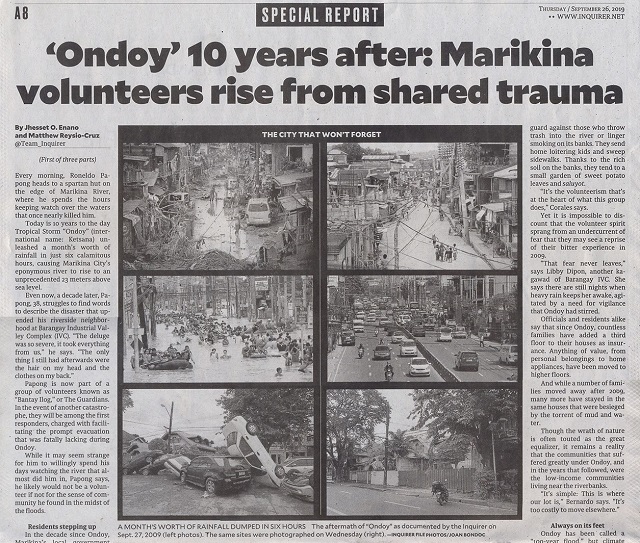Remembering Ondoy: Lessons learned, more to do

CHEERS TO media organizations that produced special reports on the commemoration of the tenth year of Typhoon Ondoy, which dumped a whole month’s rainfall in just six hours on Metro Manila and surrounding areas. Philippine Daily Inquirer provided the most comprehensive coverage; its three-part report discussed the improvement of government’s disaster response mechanisms a decade since the incident and, significantly, identified gaps in implementation.
Part 1 described the collective efforts of the local government and residents of Marikina City, which was hardest-hit by the typhoon. Marikina’s Disaster Risk Reduction Management (DRRM) Office now provides different communities training in disaster preparedness. Marikina has also mobilized volunteers to facilitate evacuation in case of another disaster. The local government is also regularly dredging the Marikina River, and unclogging drains.
Part 2 examined Metro Manila’s capacity to cope with another typhoon of the same magnitude as Ondoy, reporting on the pumping stations added by Department of Public Works and Highways (DPWH) and the Metro Manila Development Authority (MMDA), along with Metro Manila Flood Management Master Plan, which involves both structural and nonstructural mitigation methods. The report observed that implementation, which has until 2035 to complete, has been slow.
Mahar Lagmay, executive director of Project NOAH (Nationwide Operational Assessment of Hazards), told the Inquirer that science-based planning is needed in disaster mitigation, as “the failure to anticipate is the problem of resilience.” Lagmay said the government must invest in current technologies and tap local scientists, as Project NOAH’s flood projections differ significantly from those of DPWH.
Part 3 explored gaps in the implementation of the two post-Ondoy laws: the Climate Change Act and the Philippine Disaster Risk Reduction and Management Act. The Inquirer cited the observation of civil society groups that rather than mitigation and prevention, response and recovery have been the focus of the implementation of current policies. For instance, the current administration’s proposed creation of a Department of Disaster Resilience only puts emphasis on disaster response and would “shut out civil society organizations from discussions on climate and disaster.”
Other media organizations reported on related issues. News Night called attention to quarrying in Rizal province and property developments in the forested areas of the Marikina watershed that may again cause flooding in the city. GMA News Online, BusinessMirror and CNN Philippines’s online edition told the stories of Ondoy survivors and how they recovered from it. CNN Philippines also reported that state weather bureau PAGASA is now better equipped with newly-acquired tools and monitoring systems in place, but that the government is not giving enough funding for climate change.
Typhoons come and go in the Philippines, and the media have performed well in covering disasters. With climate change hitting close to home, discussions that go beyond weather events are needed now more than ever.
Leave a Reply